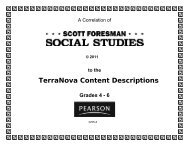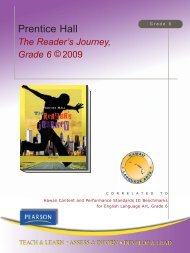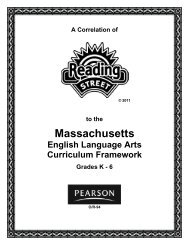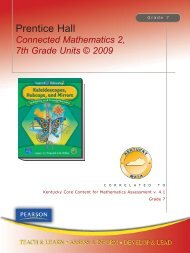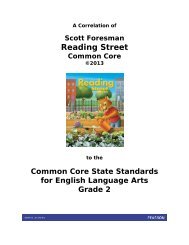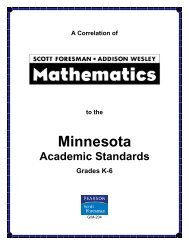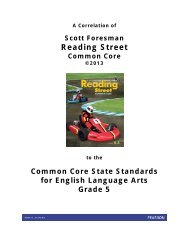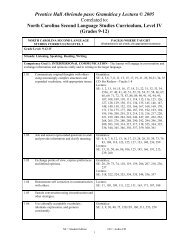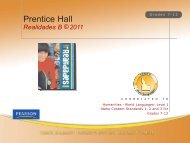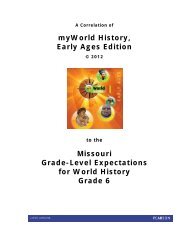SCOTT FORESMAN SOCIAL STUDIES, c. 2008, Grades ... - Pearson
SCOTT FORESMAN SOCIAL STUDIES, c. 2008, Grades ... - Pearson
SCOTT FORESMAN SOCIAL STUDIES, c. 2008, Grades ... - Pearson
You also want an ePaper? Increase the reach of your titles
YUMPU automatically turns print PDFs into web optimized ePapers that Google loves.
A Correlation ofto theHawaiiContent and PerformanceStandards III<strong>Grades</strong> K-6P/SS-8
Scott Foresman Social StudiesThis document demonstrates the high degree of success students will achieve whenusing Scott Foresman Social Studies in meeting the Hawaii Content and PerformanceStandards III. Correlation page references are to the Teacher’s Edition. Lessons in theTeacher’s Edition contain facsimile Student Edition pages.Scott Foresman is pleased to introduce Scott Foresman Social Studies,Kindergarten through Grade 6 - the social studies program that helps every childbecome an active, involved, and informed citizen.ContentScott Foresman Social Studies content covers the key social studies strands:Citizenship, Culture, Economics, Geography, Government, History andScience/Technology. Scott Foresman Social Studies content is organized for aflexible teaching plan. If time is short, teachers may use the Quick Teaching Plan tocover the core content and skills or to add depth, teachers may use the wealth ofinformation in each unit.AccessibilityScott Foresman Social Studies provides systematic instruction to improvecomprehension and to reach out to all learners. In every unit, reading skills aredeveloped through built-in lessons. Target comprehension skills are pre-taught and thenapplied throughout the unit for sustained practice. Graphic organizers provide supportfor every skill.MotivationScott Foresman Social Studies is filled with compelling visuals, intriguing facts, andexciting real-world learning. Colonial Williamsburg Lessons provide exciting, specialfeatures from the nation’s largest living museum. Dorling Kindersley Visual Lessonsprovide bold, large-as life photographs with interesting, easy-to-read expositorycaptions. Music lessons introduce or reinforce important concepts and vocabulary.Discovery Channel School projects provide exclusive, hands-on unit projects thatsynthesize and enhance learning. A special feature entitled You Are There providescaptivating suspense-packed reading that builds excitement and lets studentsexperience the event from a personal perspective. A Web-Based Information Centercontinually updates information, maps, and biographies.AccountabilityScott Foresman Social Studies provides built-in skill lessons in every unit and multipleassessment tools to develop thinking citizens. Informal assessment opportunitiesmonitor children’s learning and provide If/then guidelines with specific reteachingstrategies and effective practice. Formal assessment opportunities assess children’slearning and provide practice for key test-taking skills. Test-taking strategy lessonsprovide test preparation for national and state tests.
TABLE OF CONTENTSKindergarten………………………………...…………………………………….….……..…1Grade One……………………………………………………………………….…….…..…....4Grade Two………………………………………………………………..……………....….....7Grade Three…………………………………………………………………..…………....….11Grade Four……………………………………………………………………………...….....15Grade Five……………………………………………………………………………….….....19Grade Six……………………………………………………………………………….……...24
Scott Foresman Social Studies—Here We Goto theHawaii Content and Performance Standards IIIKindergartenStrand: Historical UnderstandingStandard 1: Historical Understanding: CHANGE, CONTINUITY, AND CAUSALITY-Understand change and/or continuity and cause and/or effect in historyTopic: Chronological ThinkingBenchmark SS.K.1.1 Explain change and continuity over time, using calendarsand simple timelines127-130, 259-262, 305-308, 313-316, TR 17-TR 28Standard 2: Historical Understanding: INQUIRY, EMPATHY AND PERSPECTIVE- Usethe tools and methods of inquiry, perspective, and empathy to explain historical eventswith multiple interpretations and judge the past on its own termsThere are no benchmarks for this standard for this Grade/Course.Strand: HistoryStandard 3: History: HISTORICAL CONTENT-Understand people now and then, hereand now (learning, living, working together)Topic: CelebrationsBenchmark SS.K.3.1 Describe historically significant events and observancesin American history93-96, 263-266, 267-2701 Kindergarten
Scott Foresman Social StudiesHawaii Content and Performance Standards IIIStrand: Political Science/CivicsStandard 4: Political Science/Civics: GOVERNANCE, DEMOCRACY, ANDINTERACTION-Understand the purpose and historical impact of political institutions, theprinciples and values of American constitutional democracy, and the similarities anddifferences in government across cultural perspectivesTopic: Governance, Power, and AuthorityBenchmark SS.K.4.1 Identify rules that apply in different settings and theresults from complying or not complying with these rules27-30, 35-38, 39-42, 81-84Standard 5: Political Science/Civics: PARTICIPATION AND CITIZENSHIP-Understandroles, rights (personal, economic, political), and responsibilities of American citizens andexercise them in civic actionTopic: Rights and ResponsibilitiesBenchmark SS.K.5.1 Describe his or her rights and demonstrateresponsibilities of self in classroom, school, and neighborhood settings27-30, 35-38, 39-42, 81-84Topic: Civic ParticipationBenchmark SS.K.5.2 Demonstrate ways to improve the quality of life in ownschool or community35-38, 39-42, 81-84, 85-88, 225-229Strand: Cultural AnthropologyStandard 6: Cultural Anthropology: SYSTEMS, DYNAMICS, AND INQUIRY-Understand culture as a system of beliefs, knowledge, and practices shared by a groupand understand how cultural systems change over timeTopic: Cultural Systems and PracticesBenchmark SS.K.6.1 Explain how and why people from different culturesobserve different holidays/celebrations93-97, 267-270, 309-3122 Kindergarten
Scott Foresman Social StudiesHawaii Content and Performance Standards IIIStrand: GeographyStandard 7: Geography: WORLD IN SPATIAL TERMS-Use geographic representationsto organize, analyze, and present information on people, places, and environments andunderstand the nature and interaction of geographic regions and societies around theworldTopic: Physical characteristics in Spatial TermsBenchmark SS.K.7.1 Identify location and physical characteristics representedon maps and globes (e.g., land, water, roads, cities)193-196, 197-200, 201-204, 205-208, 209-212, 213-216, 217-221, 222-224Benchmark SS.K.7.2 Use terms to describe relative location (i.e., above/below,near/far, left/right, and cardinal directions)31-34, 73-76Strand: EconomicsStandard 8: Economics: RESOURCES, MARKETS, AND GOVERNMENT-Understandeconomic concepts and the characteristics of various economic systemsTopic: Limited Resources and ChoiceBenchmark SS.K.8.1 Explain people's basic needs and how they fulfill them143-146, 147-150, 151-155, 156-158Topic: Role and Function of MarketsBenchmark SS.K.8.2 Differentiate buyers (e.g., a parent or caregiver) andsellers (e.g., a storeowner or other producer)131-134, 135-138, 139-1423 Kindergarten
Scott Foresman Social Studies—All Togetherto theHawaii Content and Performance Standards IIIGrade OneStrand: Historical UnderstandingStandard 1: Historical Understanding: CHANGE, CONTINUITY, AND CAUSALITY-Understand change and/or continuity and cause and/or effect in historyTopic: Chronological ThinkingBenchmark SS.1.1.1 Distinguish temporal structures (i.e., beginning, middle,and end) in stories and historical narratives92-93, 94-97, 146-147, 196-199, 202-205, 210-211Standard 2: Historical Understanding: INQUIRY, EMPATHY AND PERSPECTIVE- Usethe tools and methods of inquiry, perspective, and empathy to explain historical eventswith multiple interpretations and judge the past on its own termsTopic: Historical InquiryBenchmark SS.1.2.1 Use a variety of primary sources (e.g., artifacts, letters,photographs) to gain an understanding of historical eventsRepresentative Pages: 28-35, 58-59, 66-69, 116-119, 194-195, 206-209, 212-217,222-223, 240-243, 250-253Strand: HistoryStandard 3: History: HISTORICAL CONTENT- Understand children, people, andgroups in time and placeTopic: A Child’s Place in HistoryBenchmark SS.1.3.1 Compare own life with those of children in historyRepresentative Pages: 12-13, 18-19, 56-59, 102-103, 190-195, 196-199, 202-205,206-207, 212-215, 258-2614 Grade One
Scott Foresman Social StudiesHawaii Content and Performance Standards IIITopic: Significant Events in American HistoryBenchmark SS.1.3.2 Describe the lives of people who significantly impactedAmerican historyRepresentative Pages: 32-33, 68-69, 114-115, 122-123, 168-169, 190-199, 202-207,212-217, 222-223, 246-249Strand: Political Science/CivicsStandard 4: Political Science/Civics: GOVERNANCE, DEMOCRACY, ANDINTERACTION-Understand the purpose and historical impact of political institutions, theprinciples and values of American constitutional democracy, and the similarities anddifferences in government across cultural perspectivesTopic: Governance, Power, and AuthorityBenchmark SS.1.4.1 Explain the purpose of rules22-27, 70-71, 218-221Benchmark SS.1.4.2 Explain the difference between authority and powerCan be developed from: E14-E15, 22-25, 26-27, 70-71, 218-221Topic: Principles and Values of DemocracyBenchmark SS.1.4.3 Explain historical symbols of American nationalismE12-E13, E16, 16, 208-211, 224-225Benchmark SS.1.4.4 Explain shared democratic values, including equality,common good, and individual rightsE12-E15, 68-71, 72-73, 114-115, 202-207, 212-215, 216-217, 218-221, 222-223Standard 5: Political Science/Civics: PARTICIPATION AND CITIZENSHIP-Understandroles, rights (personal, economic, political), and responsibilities of American citizens andexercise them in civic actionTopic: Rights and ResponsibilitiesBenchmark SS.1.5.1 Identify rights and responsibilities of community leadersE14-E15, 22-25, 26-27, 70-71, 218-2215 Grade One
Scott Foresman Social StudiesHawaii Content and Performance Standards IIIStrand: Cultural AnthropologyStandard 6: Cultural Anthropology: SYSTEMS, DYNAMICS, AND INQUIRY-Understand culture as a system of beliefs, knowledge, and practices shared by a groupand understand how cultural systems change over timeTopic: Cultural Systems and PracticesBenchmark SS.1.6.1 Describe ways in which own and other cultures expresscultural beliefs and practices through stories and/or legends176-177, 266-267Strand: GeographyStandard 7: Geography: WORLD IN SPATIAL TERMS-Use geographic representationsto organize, analyze, and present information on people, places, and environments andunderstand the nature and interaction of geographic regions and societies around theworldTopic: Human and Physical Characteristics in Spatial TermsBenchmark SS.1.7.1 Construct and use simple maps to represent physical andhuman characteristics of a community50-53, 54-55, 60-61, 74-77, 120-121, 154-155Strand: EconomicsStandard 8: Economics: RESOURCES, MARKETS, AND GOVERNMENT-Understandeconomic concepts and the characteristics of various economic systemsTopic: Limited Resources and ChoiceBenchmark SS.1.8.1 Compare needs and wants100-101Topic: Economic InterdependenceBenchmark SS.1.8.2 Explain how people trade or use money to obtain goodsand services104-105, 108-111Topic: Role and Function of MarketsBenchmark SS.1.8.3 Define various goods (things that people need or want)and services (jobs people perform that satisfy people's needs or wants)108-1116 Grade One
Scott Foresman Social Studies—People and Placesto theHawaii Content and Performance Standards IIIGrade TwoStrand: Historical UnderstandingStandard 1: Historical Understanding: CHANGE, CONTINUITY, AND CAUSALITY-Understand change and/or continuity and cause and/or effect in historyTopic: Chronological ThinkingBenchmark SS.2.1.1 Construct timelines to sequence events226-227, 240Standard 2: Historical Understanding: INQUIRY, EMPATHY AND PERSPECTIVE- Usethe tools and methods of inquiry, perspective, and empathy to explain historical eventswith multiple interpretations and judge the past on its own termsTopic: Historical InquiryBenchmark SS.2.2.1 Investigate the history of families using level-appropriateprimary sources (e.g., artifacts, photographs, interviews, documents)Representative Pages: 22-23, 66-67, 90-91, 120-123, 188-189, 202-225, 230-233,236-237, 264-267, 272-275Strand: HistoryStandard 3: History: HISTORICAL CONTENT- Understand sharing and caring forpeople and earthTopic: StewardshipBenchmark SS.2.3.1 Describe ways in which specific government agencies areresponsible for environmental issues and concernsCan be developed from: 76-79, 82-857 Grade Two
Scott Foresman Social StudiesHawaii Content and Performance Standards IIIStrand: Political Science/CivicsStandard 4: Political Science/Civics: GOVERNANCE, DEMOCRACY, ANDINTERACTION-Understand the purpose and historical impact of political institutions, theprinciples and values of American constitutional democracy, and the similarities anddifferences in government across cultural perspectivesTopic: Governance, Power, and AuthorityBenchmark SS.2.4.1 Describe the different ways people gain authority and thelimits of such authorityRepresentative Pages: E14-E15, 8-11, 154-157, 160-163, 166-169, 170-171, 172-175, 176-177, 178-179, 180-183Standard 5: Political Science/Civics: PARTICIPATION AND CITIZENSHIP-Understandroles, rights (personal, economic, political), and responsibilities of American citizens andexercise them in civic actionTopic: Rights and ResponsibilitiesBenchmark SS.2.5.1 Demonstrate own roles and responsibilities in caring forothers and the environment8-11, 76-79, 82-85, 154-157Strand: Cultural AnthropologyStandard 6: Cultural Anthropology: SYSTEMS, DYNAMICS, AND INQUIRY-Understand culture as a system of beliefs, knowledge, and practices shared by a groupand understand how cultural systems change over timeTopic: Cultural Systems and practicesBenchmark SS.2.6.1 Describe ways in which own and other cultures expresstheir cultural beliefs and practices through music and art90-91, 180-183, 188-189, 236-237, 272-275, 284-285Strand: GeographyStandard 7: Geography: WORLD IN SPATIAL TERMS-Use geographic representationsto organize, analyze, and present information on people, places, and environments andunderstand the nature and interaction of geographic regions and societies around theworld8 Grade Two
Scott Foresman Social StudiesHawaii Content and Performance Standards IIITopic: Human and Physical Characteristics in Spatial TermsBenchmark SS.2.7.1 Identify and explain the human (man-made) and physical(natural) characteristics of a neighborhood or the community16-19, 20-21, 22-23, 24-27, 56-59, 60-61, 62-65Benchmark SS.2.7.2 Describe the purpose and features of maps and globesRepresentative Pages: 20-21, 46, 56-61, 93, 124-125, 144, 184-185, 192, 214-215,239Topic: Environment and SocietyBenchmark SS.2.7.3 Describe a variety of the earth's natural resources (e.g.,water, forests, and oil) and ways in which people use them76-79, 82-85Benchmark SS.2.7.4 Analyze and demonstrate ways to protect and preservethe local environment76-79, 82-85, 88-89Strand: EconomicsStandard 8: Economics: RESOURCES, MARKETS, AND GOVERNMENT-Understandeconomic concepts and the characteristics of various economic systemsTopic: Limited Resources and ChoiceBenchmark SS.2.8.1 Explain scarcity and its effects on daily lifeCan be developed from: 104-107Benchmark SS.2.8.2 Categorize resources as natural, capital, or human76-79, 82-85Topic: Economic InterdependenceBenchmark SS.2.8.3 Explain how people benefit from trade (the exchange ofgoods and services)104-107, 120-123, 134-137, 138-1399 Grade Two
Scott Foresman Social StudiesHawaii Content and Performance Standards IIITopic: Role and Function of MarketsBenchmark SS.2.8.4 Compare the roles of buyers and sellers and explain howthey depend upon each other104-107, 120-123, 134-137, 138-139Topic: Role of GovernmentBenchmark SS.2.8.5 Explain the responsibility of the government to providegoods and services112-11510 Grade Two
Scott Foresman Social Studies—Communitiesto theHawaii Content and Performance Standards IIIGrade ThreeStrand: Historical UnderstandingStandard 1: Historical Understanding: CHANGE, CONTINUITY, AND CAUSALITY-Understand change and/or continuity and cause and/or effect in historyTopic: Causes and Effects In HistoryBenchmark SS.3.1.1 Explain cause and effect relationships in stories andhistorical narrativesRepresentative Pages: 93-94, 161-162, 204-205, 208-209, 219-220, 238-239, 274-275, 310-311, 329, 370Standard 2: Historical Understanding: INQUIRY, EMPATHY AND PERSPECTIVE- Usethe tools and methods of inquiry, perspective, and empathy to explain historical eventswith multiple interpretations and judge the past on its own termsTopic: Historical InquiryBenchmark SS.3.2.1 Investigate the history of communities over time usinglevel-appropriate primary sources (e.g., maps, photos, oral histories, letters,and newspapers)Representative Pages: H4-H5, 60-61, 82-89, 94, 124-125, 128-129, 216-219, 228-229, 296-297, 344-345Topic: Historical Perspectives and InterpretationsBenchmark SS.3.2.2 Analyze varying perspectives of an experience or eventbased on the differing viewpoints of the teller, listener, and /or the participants228-229, 238-239, 362-363, 381, 39611 Grade Three
Scott Foresman Social StudiesHawaii Content and Performance Standards IIIStrand: HistoryStandard 3: History: HISTORICAL CONTENT-Understand change, cause and effect,and continuity in history and contemporary lifeTopic: Community Life Past and PresentBenchmark SS.3.3.1 Analyze issues and concerns of own community andthose of a similar community in the past26-29, 179, 208-209Strand: Political Science/CivicsStandard 4: Political Science/Civics: GOVERNANCE, DEMOCRACY, ANDINTERACTION-Understand the purpose and historical impact of political institutions, theprinciples and values of American constitutional democracy, and the similarities anddifferences in government across cultural perspectivesTopic: Governance, Power, and AuthorityBenchmark SS.3.4.1 Explain the purpose of rules and laws and the differencesbetween them370-371, 376-379, 398-401Benchmark SS.3.4.2 Describe ways in which people exercise power withoutauthorityCan be developed from: 376-379, 398-401Standard 5: Political Science/Civics: PARTICIPATION AND CITIZENSHIP-Understandroles, rights (personal, economic, political), and responsibilities of American citizens andexercise them in civic actionTopic: Rights and ResponsibilitiesBenchmark SS.3.5.1 Describe roles and rights of citizenship and demonstrateresponsibilities of citizenshipE12-E13, H2-H3, 90-91, 376-379, 390-395, 398-40112 Grade Three
Scott Foresman Social StudiesHawaii Content and Performance Standards IIIStrand: Cultural AnthropologyStandard 6: Cultural Anthropology: SYSTEMS, DYNAMICS, AND INQUIRY-Understand culture as a system of beliefs, knowledge, and practices shared by a groupand understand how cultural systems change over timeTopic: Cultural Diversity and UnityBenchmark SS.3.6.1 Explain that different cultures have unique values, beliefs,and practicesRepresentative Pages: 26-31, 78-81, 84-95, 104-109, 112-113, 124-125, 214-221,224-227, 230-235, 358-361Topic: Cultural InquiryBenchmark SS.3.6.2 Make informed judgments about cultures based onevidence from cultural artifactsRepresentative Pages: H4-H5, 60-61, 82-89, 94, 124-125, 128-129, 216-219, 228-229, 296-297, 344-345Topic: Cultural Dynamics/Change and ContinuityBenchmark SS.3.6.3 Explain how cultural elements (e.g., language, art, music,stories, legends, and traditions) can change over time and explain possiblereasons for that changeRepresentative Pages: E10-E11, 78-81, 84-95, 104-109, 112-113, 120-123, 242-247, 250-255, 258-263, 266-269Strand: GeographyStandard 7: Geography: WORLD IN SPATIAL TERMS-Use geographic representationsto organize, analyze, and present information on people, places, and environments andunderstand the nature and interaction of geographic regions and societies around theworldTopic: Human and Physical Characteristics in Spatial TermsBenchmark SS.3.7.1 Use geographic representations (e.g., maps, globes,graphs, charts, models) to organize and analyze geographic informationRepresentative Pages: H12-H20, 32-33, 51, 88, 98-99, 110-111, 158-159, 174, 222-223, 388-38913 Grade Three
Scott Foresman Social StudiesHawaii Content and Performance Standards IIITopic: Places and RegionsBenchmark SS.3.7.2 Compare the physical and human characteristics ofdifferent communities and regionsRepresentative Pages: 28-23, 26-29, 38-45, 48-53, 142-147, 150-155, 172-175, 178-183, 186-189, 224-227Benchmark SS.3.7.3 Describe the physical and human characteristics thatmake different regions uniqueRepresentative Pages: 18-23, 26-29, 38-45, 48-53, 114-117, 142-147, 150-155, 172-175, 178-183, 186-189Topic: Environment and SocietyBenchmark SS.3.7.4 Examine the ways in which people modify the physicalenvironment and the effects of these changesRepresentative Pages: 38-45, 160-165, 172-175, 178-183, 186-189, 214-221, 224-227, 230-235, 242-247, 318-323Topic: Human SystemsBenchmark SS.3.7.5 Examine the economic and geographic factors thatinfluence why people migrate and where they settle74-77, 84-89, 90-95Strand: EconomicsStandard 8: Economics: RESOURCES, MARKETS, AND GOVERNMENT-Understandeconomic concepts and the characteristics of various economic systemsTopic: Limited Resources and ChoiceBenchmark SS.3.8.1 Explain that opportunity cost is the best alternative givenup when making a choice300-303, 304-305Benchmark SS.3.8.2 Explain that goods and resources are limited becausethere are not enough natural, human, and capital resources to satisfyeveryone's wants306-311, 318-323, 328-333Topic: Economic InterdependenceBenchmark SS.3.8.3 Describe how money makes it easy to trade goods andservices296-297, 334-33914 Grade Three
Scott Foresman Social Studies—Regionsto theHawaii Content and Performance Standards IIIGrade FourStrand: Historical UnderstandingStandard 1: Historical Understanding: CHANGE, CONTINUITY, AND CAUSALITY-Understand change and/or continuity and cause and/or effect in historyTopic: Historical Change and ContinuityBenchmark SS.4.1.1 Describe both change and continuity of aspects ofHawaiian culture (including religion, land use, and social systems)E14-E15Standard 2: Historical Understanding: INQUIRY, EMPATHY AND PERSPECTIVE- Usethe tools and methods of inquiry, perspective, and empathy to explain historical eventswith multiple interpretations and judge the past on its own termsTopic: Historical Perspectives and InterpretationsBenchmark SS.4.2.1 Categorize sources of information as primary orsecondary and as providing historical fact or opinionH4-H5, 208-209, 217, 221, 330-331, 353, 357Strand: HistoryStandard 3: History: PRE-CONTACT HAWAII HISTORY-Understand the people,events, problems, and ideas that were significant in pre-contact Hawaiian historyTopic: Early Hawaiian SocietyBenchmark SS.4.3.1 Explain the origins and culture of early HawaiiansCan be developed from: R42-R44Benchmark SS.4.3.2 Explain the history of Hawaii's early economyCan be developed from: 384-388, 406, R40-4115 Grade Four
Scott Foresman Social StudiesHawaii Content and Performance Standards IIIBenchmark SS.4.3.3 Describe the cultural contributions of different groups tothe development of HawaiiCan be developed from: R42-R44Topic: Exploration, Migration, and SettlementBenchmark SS.4.3.4 Describe the theories of early migrations from parts ofPolynesia to Hawaii, including migration myths and legendsCan be developed from: R42-R43Benchmark SS.4.3.5 Identify reasons that early explorers, settlers, andimmigrants came to Hawaii (including the influence of Pa'ao) or the Polynesianregion and describe what their lives and experiences were likeCan be developed from: R42-R43Benchmark SS.4.3.6 Illustrate patterns and changes in population in Hawaiiover a period of timeCan be developed from: R36, R42-R43Benchmark SS.4.3.7 Describe the interactions (including economic exchangesand wars) among different cultural and ethnic groups in early HawaiiCan be developed from: R42-R43Topic: Hawaiian State GovernmentBenchmark SS.4.3.8 Explain the evolution of Hawaii state governmentE14-E15Topic: Events in Hawaiian HistoryBenchmark SS.4.3.9 Place key events in pre-contact Hawaiian history inchronological order (including volcanic origins, migrations, and CaptainCook's arrival)Can be developed from: R42-R43Benchmark SS.4.3.10 Describe how significant people, including those oflegend (including Papa and Wakea, Pele, and Pa'ao) affected pre-contactHawaiiCan be developed from: R42-R4416 Grade Four
Scott Foresman Social StudiesHawaii Content and Performance Standards IIIStrand: Political Science/CivicsStandard 4: Political Science/Civics: GOVERNANCE AND INTERACTION-Understandthe purpose and historical impact of political institutions, the principles and values of theHawaiian kapu system, and the similarities and differences in government acrosscultural perspectivesTopic: Governance, Power, and AuthorityBenchmark SS.4.4.1 Evaluate the kapu system in the context of the timeCan be developed from: E14-E15Standard 5: Political Science/Civics: PARTICIPATION AND CITIZENSHIP- Understandroles, rights (personal, economic, political), and responsibilities of the Ali’i, Kahuna,Maka’ainana and Kaua classes and how they participated in civic lifeTopic: Civic ParticipationBenchmark SS.4.5.1 Describe the roles, rights, and responsibilities of eachclass in pre-contact HawaiiCan be developed from: E14-E15Strand: Cultural AnthropologyStandard 6: Cultural Anthropology: SYSTEMS, DYNAMICS, AND INQUIRY-Understand culture as a system of beliefs, knowledge, and practices shared by a groupand understand how cultural systems change over timeTopic: Cultural Systems and PracticesBenchmark SS.4.6.1 Explain how language, traditional lore, music, dance,artifacts, traditional practices, beliefs, values, and behaviors are elements ofculture and contribute to the preservation of cultureRepresentative Pages: 38-44, 126-129, 188-192, 214-215, 256-261, 283, 286-287,324-328, 394-399, 410-415Topic: Cultural Dynamics/Change and ContinuityBenchmark SS.4.6.2 Describe how individuals or groups deal with conflict,cooperation, and interdependence within the ahupua'aCan be developed from: 81-8217 Grade Four
Scott Foresman Social StudiesHawaii Content and Performance Standards IIIBenchmark SS.4.6.3 Describe the changes in Hawaiian culture through contactwith WesternersCan be developed from: R42-R43Strand: GeographyStandard 7: Geography: WORLD IN SPATIAL TERMS-Use geographic representationsto organize, analyze, and present information on people, places, and environments andunderstand the nature and interaction of geographic regions and societies around theworldTopic: Places and RegionsBenchmark SS.4.7.1 Identify the major geographic characteristics anddemographics of the pre-contact Hawaiian archipelago, including its relativelocation to other major land masses22, 368-375, 382-383, R36-R39Topic: World In Spatial TermsBenchmark SS.4.7.2 Collect, organize, and analyze data to interpret andconstruct geographic representationsRepresentative Pages: H12-H22, 24-25, 54-55, 86-87, 144, 170-171, 279, 341, 401,408-409Topic: Environment and SocietyBenchmark SS.4.7.3 Analyze the consequences of human modification of thephysical environment in Hawaii using geographic representations (includinglo'i kalo and loko i'a)Can be developed from: 368-375Strand: EconomicsStandard 8: Economics: RESOURCES, MARKETS, AND GOVERNMENT-Understandeconomic concepts and the characteristics of various economic systemsTopic: Economic InterdependenceBenchmark SS.4.8.1 Describe the economic interdependence among thoseliving in the ‘ahupua'aCan be developed from: R4118 Grade Four
Scott Foresman Social StudiesBuilding a Nation and The United Statesto theHawaii Content and Performance Standards IIIGrade FiveStrand: Historical UnderstandingStandard 1: Historical Understanding: CHANGE, CONTINUITY, AND CAUSALITY-Understand change and/or continuity and cause and/or effect in historyTopic: Chronological ThinkingBenchmark SS.5.1.1 Use chronological order to explain causal relationshipsbetween and among people and eventsBUILDING A NATION: 109, 116-117, 130-131, 138, 145, 167, 243, 264-265, 282THE UNITED STATES: Representative Pages: 109, 116-117, 130-131, 167, 243,264-265, 282, 534-535, 582, 648Standard 2: Historical Understanding: INQUIRY, EMPATHY AND PERSPECTIVE- Usethe tools and methods of inquiry, perspective, and empathy to explain historical eventswith multiple interpretations and judge the past on its own termsTopic: Historical Perspectives and InterpretationsBenchmark SS.5.2.1 Analyze how beliefs and education and/or the society inwhich a person resides shape his/her "point of view"BUILDING A NATION: 222-223, 310-311, 368-369, 468-469THE UNITED STATES: 222-223, 310-311, 368-369, 468-469, 576-577Topic: Historical EmpathyBenchmark SS.5.2.2 Judge the past in the context of the time instead ofimposing present norms and values on historical eventsBUILDING A NATION: Can be developed from: H4-H5THE UNITED STATES: Can be developed from: H4-H519 Grade Five
Scott Foresman Social StudiesHawaii Content and Performance Standards IIIStrand: HistoryStandard 3: History: EARLY AMERICAN HISTORY-Understand important historicalevents through the RevolutionTopic: Exploration, Migration, and SettlementBenchmark SS.5.3.1 Identify what Europeans sought (e.g., route to Asia) andwhat they found (e.g., new crops) during the Age of ExplorationBUILDING A NATION: 110-115, 134-139THE UNITED STATES: 110-115, 134-139Benchmark SS.5.3.2 Examine the interactions between Europeans and NativeAmericans in North AmericaBUILDING A NATION: 134-138, 142-145, 149, 160, 170-171, 180, 232-237, 240-243, 246-251THE UNITED STATES: 134-138, 142-145, 149, 160, 170-171, 180, 232-237, 240-243, 246-251Benchmark SS.5.3.3 Describe the hardships experienced by European settlersin colonial AmericaBUILDING A NATION: 156-162, 164-167, 168-173, 176-182, 202-207, 210-214,216-220THE UNITED STATES: 156-162, 164-167, 168-173, 176-182, 202-207, 210-214,216-220Topic: Colonial American SocietyBenchmark SS.5.3.4 Describe how religion and economics influenced thesettling of New England and the southern regions of British North AmericaBUILDING A NATION: 168-173, 174-175, 176-182THE UNITED STATES: 168-173, 174-175, 176-182Benchmark SS.5.3.5 Describe the major features of the economies of NewEngland (i.e., manufacturing), the mid-Atlantic colonies (i.e., trade), andsouthern regions (i.e., farming) of British North America and explain theirrelationship to geographic featuresBUILDING A NATION: 176-182, 202-207, 210-214THE UNITED STATES: 176-182, 202-207, 210-21420 Grade Five
Scott Foresman Social StudiesHawaii Content and Performance Standards IIIBenchmark SS.5.3.6 Explain how colonial America solved its labor shortageproblem with indentured servants and African slavesBUILDING A NATION: 202-207, 224-227THE UNITED STATES: 202-207, 224-227Benchmark SS.5.3.7 Illustrate the movement of African slaves to the Americasand their role in the Triangular TradeBUILDING A NATION: 206-207, 224-227THE UNITED STATES: 206-207, 224-227Benchmark SS.5.3.8 Describe conflicts between Europeans and NativeAmericans (i.e., King Philips War), among colonists, (i.e., Bacon's Rebellion),and between European powers (i.e., the French and Indian War)BUILDING A NATION: 246-251THE UNITED STATES: 246-251Benchmark SS.5.3.9 Describe the role of Puritans and Quakers in shapingcolonial societyBUILDING A NATION: 168-173, 176-182THE UNITED STATES: 168-173, 176-182Benchmark SS.5.3.10 Explain how conflict between the English governmentand the English colonies led to the outbreak of the American RevolutionBUILDING A NATION: 268-273, 276-282, 286-291THE UNITED STATES: 268-273, 276-282, 286-291Topic: Revolutionary WarBenchmark SS.5.3.11 Define the major ideas (i.e., natural rights, government bythe consent of the governed, and "all men are created equal") stated in theDeclaration of Independence and explain why they were includedBUILDING A NATION: 296-300, R26-R29THE UNITED STATES: 296-300, R26-R29Benchmark SS.5.3.12 Describe the major events of the Revolutionary War,including key battles, key alliances, and the roles played by key figuresBUILDING A NATION: 286-291, 296-300, 302-307, 314-319THE UNITED STATES: 286-291, 296-300, 302-307, 314-31921 Grade Five
Scott Foresman Social StudiesHawaii Content and Performance Standards IIIStrand: Political Science/CivicsStandard 4: Political Science/Civics: GOVERNANCE, DEMOCRACY, ANDINTERACTION-Understand the purpose and historical impact of political institutions, theprinciples and values of American constitutional democracy, and the similarities anddifferences in government across cultural perspectivesTopic American DemocracyBenchmark SS.5.4.1 Explain how colonial governments were based on keyprinciples underlying American democracy (including social contract, majorityrule, and equality of opportunity)BUILDING A NATION: 156-162, 164-167, 168-173THE UNITED STATES: 156-162, 164-167, 168-173Benchmark SS.5.4.2 Explain how participation in American democracy haschanged since the 18th centuryBUILDING A NATION: 516-521THE UNITED STATES: 516-521, 602-605, 642-644, 645, 646-648Standard 5: Political Science/Civics: PARTICIPATION AND CITIZENSHIP-Understandroles, rights (personal, economic, political), and responsibilities of American citizens andexercise them in civic actionThere are no benchmarks for this standard for this Grade/Course.Strand: Cultural AnthropologyStandard 6: Cultural Anthropology: SYSTEMS, DYNAMICS, AND INQUIRY-Understand culture as a system of beliefs, knowledge, and practices shared by a groupand understand how cultural systems change over timeTopic: Cultural InquiryBenchmark SS.5.6.1 Compare the views of Native Americans and Europeansregarding the relationship between humans and the landBUILDING A NATION: Representative Pages: 134-138, 142-145, 149, 160, 170-171, 180, 232-237, 240-243, 246-251, 381, 405-406, 431THE UNITED STATES: Representative Pages: 134-138, 142-145, 149, 160, 170-171, 180, 232-237, 240-243, 246-251, 381, 405-406, 43122 Grade Five
Scott Foresman Social StudiesHawaii Content and Performance Standards IIIStrand: GeographyStandard 7: Geography: WORLD IN SPATIAL TERMS-Use geographic representationsto organize, analyze, and present information on people, places, and environments andunderstand the nature and interaction of geographic regions and societies around theworldTopic: Human SystemsBenchmark SS.5.7.1 Explain how the Revolutionary War caused the movementof peopleBUILDING A NATION: Can be developed from: 286-291, 302-308, 314-319THE UNITED STATES: Can be developed from: 286-291, 302-308, 314-319Strand: EconomicsStandard 8: Economics: RESOURCES, MARKETS, AND GOVERNMENT-Understandeconomic concepts and the characteristics of various economic systemsTopic: Limited Resources and ChoiceBenchmark SS.5.8.1 Explain the opportunity costs considered by the settlersbefore moving to the coloniesBUILDING A NATION: 156-162, 164-167, 168-173, 176-182THE UNITED STATES: 156-162, 164-167, 168173, 176-182Topic: Role of GovernmentBenchmark SS.5.8.2 Recognize that governments raise money to pay for goodsand services (i.e., taxes) and describe why the American colonists weredissatisfied with the colonial system of taxationBUILDING A NATION: 268-273THE UNITED STATES: 268-27323 Grade Five
Scott Foresman Social Studies—The Worldto theHawaii Content and Performance Standards IIIGrade SixStrand: Historical UnderstandingStandard 1: Historical Understanding: CHANGE, CONTINUITY, AND CAUSALITY-Understand change and/or continuity and cause and/or effect in historyTopic: Causes And Effects in HistoryBenchmark SS.6.1.1 Define causal relationships in historical chronologiesRepresentative Pages: 39, 271, 304, 338, 359, 363, 395, 411, 496, 590Standard 2: Historical Understanding: INQUIRY, EMPATHY AND PERSPECTIVE- Usethe tools and methods of inquiry, perspective, and empathy to explain historical eventswith multiple interpretations and judge the past on its own termsTopic: Historical InquiryBenchmark SS.6.2.1 Frame and answer questions through historical researchRepresentative Pages: 68, 144-145, 152, 236, 280-281, 312, 364-366, 386-387,420, 472-473Topic: Historical EmpathyBenchmark SS.6.2.2 Explain the past on its own terms; not judging it solely bypresent-day norms and valuesCan be developed from: H4-H5Strand: HistoryStandard 3: History: WORLD CULTURES/HISTORY- Understand important historicalevents from ancient times through the RenaissanceTopic: Ancient Societies, 3000 B.C.E. to 500 B.C.E.Benchmark SS.6.3.1 Examine written and physical evidence from ancientsocieties in Mesopotamia, Egypt, the Indus River Valley, and the Yellow RiverValleyRepresentative Pages: 34-43, 48-50, 78-81, 84-87, 92-95, 100-103, 106-112, 114-117, 122-127, 128-13424 Grade Six
Scott Foresman Social StudiesHawaii Content and Performance Standards IIIBenchmark SS.6.3.2 Compare the writing, artifacts, and architectural remainsfrom the Maya, Aztec, Inca, and early Pacific Island societies162-165, 168-173, 174-180, 186-189, 196-201Topic: Classical Societies, 500 B.C.E to 500 C.EBenchmark SS.6.3.3 Compare classical societies, including China during thereign of Han Wudi; Maurya India under Ashoka; Greek city-states underPericles; and the Roman Empire under Augustus106-112, 128-134, 252-256, 257, 288-292Benchmark SS.6.3.4 Describe the key figures and major beliefs of the majorreligious and philosophical traditions of ancient and classical times, includingJudaism, Confucianism, Daoism, Hinduism, Buddhism, Greek philosophy,Christianity, and Islam54-59, 114-117, 136-139, 140-143, 252-255, 257, 260-264, 265, 294-297Topic: Post-Classical Societies, 500 C.E. to 1500 C.E.Benchmark SS.6.3.5 Compare post-classical societies, including China at thetime of Tang Taizong, the Abbasid dynasty at the time of Harun al-Rashid, theCarolingian Empire at the time of Charlemagne, and the Mali Empire at the timeof Mansa Musa350-355, 374-378, 396-398, 399Benchmark SS.6.3.6 Describe the trade networks, including the Silk Road andSaharan caravan trade; conflicts, including the Crusades and Mongolconquests; communications; and exchanges, including Chinese inventionsand the bubonic plague, that linked the post-classical societies350-355, 374-378, 406-411, 438-442Benchmark SS.6.3.7 Describe the re-establishment of Chinese imperial rule andthe voyages of Zheng He350-355Benchmark SS.6.3.8 Explain the impact of the Renaissance and the Europeanvoyages of exploration430-437, 438-442, 444-44925 Grade Six
Scott Foresman Social StudiesHawaii Content and Performance Standards IIIStrand: Political Science/CivicsStandard 4: Political Science/Civics: GOVERNANCE, DEMOCRACY, ANDINTERACTION-Understand the purpose and historical impact of political institutions andthe similarities and differences in government across cultural perspectivesTopic: Foundations of DemocracyBenchmark SS.6.4.1 Identify the foundations of democracy in classical Greeceand Rome252-256, 260-264, 282-287, 288-292Standard 5: Political Science/Civics: PARTICIPATION AND CITIZENSHIP-Understandroles, rights (personal, economic, political), and responsibilities of American citizens andexercise them in civic actionThere are no benchmarks for this standard for this Grade/Course.Strand: Cultural AnthropologyStandard 6: Cultural Anthropology: SYSTEMS, DYNAMICS, AND INQUIRY-Understand culture as a system of beliefs, knowledge, and practices shared by a groupand understand how cultural systems change over timeTopic: Cultural Systems and PracticesBenchmark SS.6.6.1 Examine the ways in which different cultures haveinfluenced families and communitiesRepresentative Pages: E10-E11, 54-59, 84-90, 114-117, 136-143, 260-264, 294-297, 330-338, 400-405, 654-657Topic: Cultural Dynamics/Change And ContinuityBenchmark SS.6.6.2 Use examples of changing culture to identify and analyzeways to respond to cultural differences and problems within and acrossgroups (e.g., stereotyping, ethics)Can be developed from: 654-65726 Grade Six
Scott Foresman Social StudiesHawaii Content and Performance Standards IIIStrand: GeographyStandard 7: Geography: WORLD IN SPATIAL TERMS-Use geographic representationsto organize, analyze, and present information on people, places, and environments andunderstand the nature and interaction of geographic regions and societies around theworldTopic: Places and RegionsBenchmark SS.6.7.1 Describe the development of agriculture in the Tigris,Euphrates, and Nile river valleys34-39, 40-43, 78-81, 84-90Topic: Human SystemsBenchmark SS.6.7.2 Describe the impact of printing, the compass, andgunpowder in China and Europe350-355, 406-411, 430-437Benchmark SS.6.7.3 Analyze patterns of cultural encounters and exchangesand assess their impact on societiesRepresentative Pages: 54-59, 92-95, 140-143, 174-180, 196-201, 266-269, 334-338,374-378, 406-411, 444-449Strand: EconomicsStandard 8: Economics: RESOURCES, MARKETS, AND GOVERNMENT-Understandeconomic concepts and the characteristics of various economic systemsTopic: Limited Resources and ChoiceBenchmark SS.6.8.1 Explain exchanges of salt, gold, and other trade over thetrans-Saharan trade routes and the impact of these exchanges374-378Benchmark SS.6.8.2 Describe, in terms of opportunity cost, why it was sodifficult for Christopher Columbus to find financial support for his voyagesCan be developed from: 440Benchmark SS.6.8.3 Explain the impact of the exchange of productsthroughout the Indian Ocean basin from CE 500 to CE 1500346-349, 350-355, 406-41127 Grade Six



